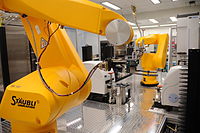
Photo from wikipedia
Many filamentous fungi are exploited as cell factories in biotechnology. Cultivated under industrially relevant submerged conditions, filamentous fungi can adopt different macromorphologies ranging from dispersed mycelia over loose clumps to… Click to show full abstract
Many filamentous fungi are exploited as cell factories in biotechnology. Cultivated under industrially relevant submerged conditions, filamentous fungi can adopt different macromorphologies ranging from dispersed mycelia over loose clumps to pellets. Central to the development of a pellet morphology is the agglomeration of spores after inoculation followed by spore germination and outgrowth into a pellet population, which is usually very heterogeneous. As the dynamics underlying population heterogeneity is not yet fully understood, we present here a new high‐throughput image analysis pipeline based on stereomicroscopy to comprehensively assess the developmental program starting from germination up to pellet formation. To demonstrate the potential of this pipeline, we used data from 44 sampling times harvested during a 48 h submerged batch cultivation of the fungal cell factory Aspergillus niger. The analysis of up to 1700 spore agglomerates and 1500 pellets per sampling time allowed the precise tracking of the morphological development of the overall culture. The data gained were used to calculate size distributions and area fractions of spores, spore agglomerates, spore agglomerates within pellets, pellets, and dispersed mycelia. This approach eventually enables the quantification of culture heterogeneities and pellet breakage.
Journal Title: Biotechnology and Bioengineering
Year Published: 2022
Link to full text (if available)
Share on Social Media: Sign Up to like & get
recommendations!